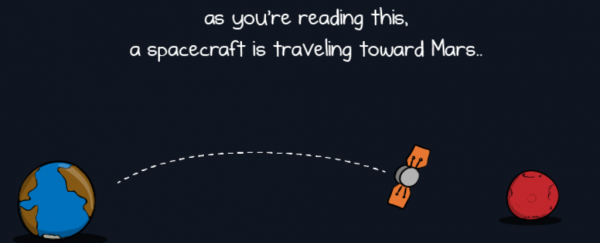On Monday a little spacecraft is going to land on Mars and begin exploring the Red Planet in a way we never have before.
If everything goes to plan (which it doesn't always) a little robot called InSight will be helping us understand the inside of Mars. But sometimes these sorts of missions are difficult to explain, and to make exciting.
That's why we're so impressed with the work of cartoonist Matthew Inman - aka The Oatmeal - who has just given InSight the pre-landing celebration it deserves.
Today he released a comic that brilliantly covers the importance, beauty, and excitement of InSight's landing (and what could go wrong), explaining just what this little lander might tell us about both Mars and Earth.
There's also a hilarious mole. We totally recommend reading the whole thing here (go on, we'll wait).
5 days until we touchdown on Mars. Here's everything you need to know about the landing: https://t.co/s9D2oX5NlO pic.twitter.com/l9ByXguBad
— The Oatmeal (@Oatmeal) November 21, 2018
Okay, now you've read that, and are as excited for InSight as we are - let's dive into some more details, as the probe is really carrying more than just one mole.
InSight is very different to the Mars rovers that have come before. It's not exploring across the land like Opportunity (RIP) and Curiosity, but will instead be digging deep - 5 metres (16 feet) deep to be exact.
It's worth around US$830 million dollars and is equipped with lots of tools built to find out about the elusive insides of the Red Planet.
For example, there's the Seismic Experiment for Interior Structure which will be measuring quakes, meteorite impacts, and any other movement that we should know about.
There's also the Heat Flow and Physical Properties Package which is a 'self-penetrating heat flow probe'. As Inman delightfully explained in his comic, that little guy (which has been nicknamed the mole) will burrow deep to measure Mars's internal temperature.
It also has something called the Rotation and Interior Structure Experiment to measure the planetary rotation of Mars. That rotation data will build on other spacecrafts' records such as Viking and Mars Pathfinder – data which is way over 20 years old now.
All this brand new information has huge implications for both Mars and Earth.
The two planets used to be exceptionally similar, and working out how Earth changed and Mars didn't means we'll be closer to understanding how life came to exist.
"One of our key questions regarding habitability is, what are the key conditions planets need for life to form?" said Sue Smrekar, InSight's deputy principal investigator at JPL.
"Understanding a planet's initial building blocks set the stage for how processes that affect the environment evolve over time."
If you want to see the livestream of the landing, you can do so below. It should go live a few hours before the landing at 12:00 pm PT (3:00 pm ET/8:00 pm GMT) on November 26.
You can also follow Inman while he live tweets the event from NASA's Jet Propulsion Laboratory in California.
